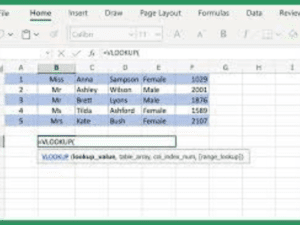How to Fix VLOOKUP Not Working
Below are the 9 ways to Fix your VLOOKUP not working.
- Check for Correct Syntax: VLOOKUP has a specific syntax that needs to be followed for it to work correctly. The syntax is as follows:
=VLOOKUP(lookup_value, table_array, col_index_num, [range_lookup])
Make sure you have entered the correct arguments in the correct order. The lookup_value is the value you are searching for, the table_array is the range of cells where you want to search for the value, col_index_num is the column number from which you want to return a value, and [range_lookup] is an optional argument that specifies whether you want an exact match or an approximate match. Double-check your formula to ensure that it matches this syntax.
- Check for Data Type Mismatch: Another common reason why VLOOKUP may not work is when there is a data type mismatch between the
lookup_valueand the data in thetable_array. VLOOKUP performs an exact match by default. So if the data types do not match, it may not return the expected result. For example, if you are searching for a number but the data in thetable_arrayis stored as text, VLOOKUP may not work. Make sure that the data types in thelookup_valueand thetable_arraymatch. - Check for Hidden Characters: Sometimes, hidden characters such as spaces or non-printable characters can cause VLOOKUP to fail. These hidden characters can be present in either the
lookup_valueor thetable_array, and they may not be visible to the naked eye. To fix this issue, you can use theTRIMfunction to remove any leading or trailing spaces from thelookup_valueand thetable_array. For example:
=VLOOKUP(TRIM(lookup_value), TRIM(table_array), col_index_num, [range_lookup])
-
Check for #N/A Error: If the VLOOKUP function returns a
#N/Aerror, it means that it could not find a match for thelookup_valuein thetable_array. This could happen if the value you are searching for is not present in the specified range. To fix this, you can either double-check thelookup_valueto ensure it exists in thetable_array, or you can use theIFERRORfunction to handle the error gracefully. For example:
=IFERROR(VLOOKUP(lookup_value, table_array, col_index_num, [range_lookup]), "Not Found")- Check for Absolute Cell References: VLOOKUP uses relative cell references by default. This means that if you copy the formula to another cell, the references may change. If you want to fix the range of cells that VLOOKUP searches, you can use absolute cell references by adding a
$before the column letter and/or row number. For example:
=VLOOKUP(lookup_value, $A$1:$B$10, col_index_num, [range_lookup])
This will ensure that the table_array remains fixed even if you copy the formula to other cells.
- Check for Sorting and Formatting: VLOOKUP requires the
table_arrayto be sorted in ascending order based on the column that you are using as the reference. If thetable_arrayis not sorted, VLOOKUP may not return the correct result. Additionally, VLOOKUP is case-insensitive, so if thelookup_valueand the data in thetable_arrayhave different capitalization, VLOOKUP may not work as expected. To fix this, make sure that thetable_arrayis sorted and the data is formatted consistently. - Check for Multiple Matches: If there are multiple occurrences of the
lookup_valuein thetable_array, VLOOKUP will only return the first match it encounters. If you need to retrieve all the matches, you may need to use a different formula. Formulas like INDEX and MATCH, or a combination of other functions. For example:
=INDEX(column_to_return, SMALL(IF(lookup_value=lookup_range, ROW(lookup_range)-MIN(ROW(lookup_range))+1, ""), ROW()))Note: This is an array formula, so it needs to be entered using Ctrl + Shift + Enter.
- Check for External Links: If your
table_arraycontains external links to other workbooks or worksheets, VLOOKUP may not work if those links are broken or the external files are unavailable. Make sure that all the external links are valid and the referenced files are accessible. - Check for Circular References: Circular references occur when a formula refers to its own cell, or when a group of formulas refer to each other in a circular manner. Circular references can cause VLOOKUP to not work correctly. Make sure that there are no circular references in your worksheet and resolve them if they exist.
Conclusion
In conclusion, above are the 9 ways to Fix your VLOOKUP not working. If you encounter issues with VLOOKUP not working in Excel, there are several things to check and fix. Double-check the syntax, ensure that the data types match, remove hidden characters, handle errors gracefully, use absolute cell references, sort and format data properly, consider multiple matches, verify external links, and check for circular references. By following these steps, you can master the art of fixing “VLOOKUP that is not working”. Also, ensure that your Excel spreadsheets function accurately and efficiently.
Read Also:
